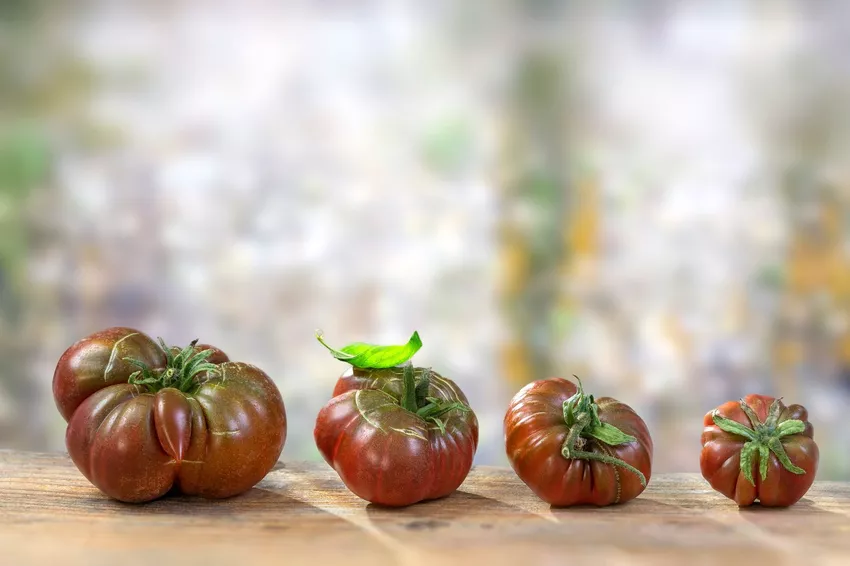What does the Black Crimean tomato variety look like and what does it taste like? We will introduce you to the tomato and explain how to properly plant and care for the tomato, also known as 'Schwarze Krim' or 'Schwarze Krim'.

The dark red to brown beefsteak tomato 'Schwarze von der Krim' has a wonderfully spicy aroma and brings variety to the garden. We will introduce you to the history, properties and requirements of the tomato variety.
Blacks from Crimea: Wanted Poster
| Synonyms | 'Black Crimea' |
| Fruit | Beefsteak tomato; dark red to violet-brown with olive green shoulders |
| Flavour | very spicy, fruity |
| Maturity | late |
| Growth | Stick tomato, up to 180 cm |
| Location | Greenhouse, protected outdoor area |
Origin and history of the Black Crimean tomato
This pretty dark beefsteak tomato originally comes from Ukraine and is named after the Crimean Peninsula. It is also marketed under the synonym 'Black Krim'. It is not known when exactly it was bred. The 'Black Krim' is an old, seed-resistant variety.
Blacks from Crimea: taste and characteristics
The 'Black from Crimea' grows to a medium height and reaches a maximum height of 180 centimetres, slightly less outdoors. It is a late-ripening variety, which is why you can only expect the first ripe fruits from the beginning to mid-August. Tomatoes of the 'Black from Crimea' variety are flat-topped, slightly ribbed and purplish-brown in colour. The shoulders around the base of the stem remain olive to dark green even when ripe. The fruits reach a weight of up to 350 grams. The dark red flesh becomes very soft when fully ripe, the skin is rather thin. The taste of 'Blacks from Crimea' can be described as sweet, very spicy and tomatoy.

Plant black Crimean tomatoes andMaintain: You should pay attention to this
The 'Black from Crimea' is an easy-care, robust and adaptable beefsteak tomato. It is therefore suitable for both greenhouse and sheltered outdoor cultivation. From the beginning of May put the 'Black from the Crimea' in the greenhouse, after the Ice Saints in mid-May in the open. To plant, dig a fairly deep hole with a spade and place the young plant in it. Fill the planting hole with a soil that is specially made for tomatoes, such as our Plantura organic tomato soil. This contains important nutrients for the young plants and thus supports growth and flowering. After planting, press down the soil well and water the 'Black Crimea' properly.
Our tip: A rain cover can prevent fruit from bursting outdoors and reduce late blight on tomatoes.
Regular pinching of the side shoots is particularly important with beefsteak tomatoes. In this way, the plant concentrates its resources on fruit formation, and the fruits ripen earlier and better. The 'Schwarze von der Krim' can be grown with a maximum of two shoots and should always be well supported and tied. Especially outdoors, you support soil life with a mulch layer, which also saves irrigation water. We also have tips for mulching and watering tomato plants. Once fruit growth begins, the plants require larger amounts of nutrients. Organic long-term fertilizers such as our Plantura organic tomato fertilizer ensure a balanced and sustainable supply of all the necessary minerals. The plant-based granules are superficially worked into the layer of soil around the tomatoes and decompose over the course of two months. Now there is a smaller additional fertilization, which will suffice until the end of the season.
Harvesting and using the ‘Black Crimea’ tomato variety
As soon as the delicate skin of the 'Blacks from the Crimea' feels soft and gives slightly when pressed with a finger, it can be harvested. Now the fruit has also turned purple-brown, indicating its ripeness. The pretty beefsteak tomato tastes best freshly sliced on bread or in a salad. The aromatic taste of the 'Blacks from the Crimea' variety is almost too good to be processed. But of course you can also use them in soups and sauces.
Would you like more colorful tomatoes? How about the still largely unknown green tomatoes? We provide the bestVarieties and show how to recognize ripe fruits.